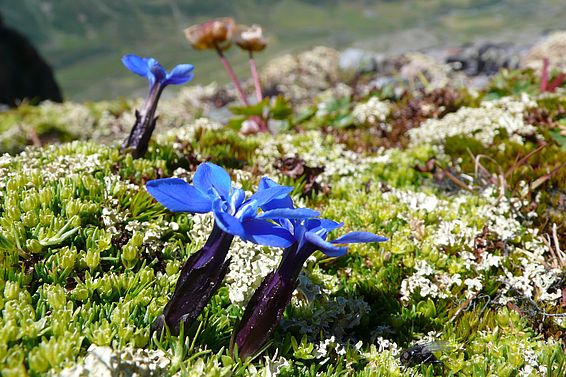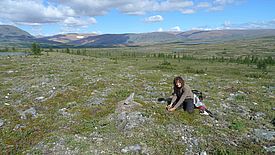Alpine flora is changing rapidly as a result of climate change. Soils are a vital but largely unexplored factor in this process. They also store the biggest amounts of CO2. However, how alpine soils will change in a warmer climate is largely unknown, according to researchers at the Swiss Federal Institute for Forest, Snow and Landscape Research (WSL), writing in the journal Science.
In mountainous areas, hidden from view beneath the soil surface, processes of vital importance to the climate and ecosystem are taking place. Over 10,000 different types of microorganisms, such as fungi and bacteria, live in alpine soils. In the alpine zone, 90% of carbon is located under the ground. Soils also play a crucial – and largely unknown – role in the changes to alpine vegetation caused by climate change.
The climate is warming particularly fast at high elevations, meaning that alpine plants are expanding their range upwards. If temperatures rise by the predicted 2 to 4 degrees Celsius over the course of this century, the growth limit for plants could rise by between 300 and 600 metres. However, plants rely on soil to store nutrients and water. Soil formation "lags a long way behind the warming climate", according to WSL soil ecologist Frank Hagedorn. Observations along melting glaciers reveal that it takes centuries, if not millennia, for new soil to form from rock.
This will favour the spread of plants that can survive with little soil, such as the alpine moon-daisy and alpine bluegrass, whereas species that prefer well-developed soils rich in humus will be left behind. As a result, the composition of communities will change in unpredictable ways, both above and below ground.
"Soils are the terra incognita of the alpine world," says Hagedorn. They are home to the greatest biodiversity of all high-mountain habitats but only a fraction of the functions performed by these organisms are known. So it is fitting that the review article in which Hagedorn and his colleagues summarise the interdependencies of plants and soil in warming mountain environments should appear in a special issue of Science marking the 250th anniversary of the birth of naturalist Alexander von Humboldt. Humboldt not only described the vegetation zones at different altitudes but also compared these zones in different mountain ranges worldwide.

Carbon store or carbon source?
The way soils change as the mountains warm up also has implications for the climate. Soils contain 90% of the carbon in alpine ecosystems, carbon which would otherwise be fuelling climate change in the form of CO2. However, this carbon storage differs from place to place. Close to the vegetation limit, more plants will grow as the climate becomes more favourable, which will result in more carbon being stored in the soil. At the same time, though, more CO2 will be released as the permafrost thaws and forest starts to colonise higher elevations. After all, current evidence suggests that soils will still lose CO2 even if new forest becomes established above the current treeline.
Indeed, the data indicate that, overall, CO2 losses from the soil will outweigh any additional carbon storage, Hagedorn explains. He carried out an experiment at Davos in which cables were used to heat the soil for six years. This led to losses of CO2 stored in the soil and changed the soil's microbial diversity, which increased the availability of nutrients for plants and so promoted their growth.
Monitoring mountain soils intensively
Despite the vital importance of these underground processes for the climate and ecosystem, little research has been done into the alpine soil that covers at least one third of Switzerland's land area. Hagedorn bemoans the fact that only one single soil profile above the forest line has been recorded by the Swiss National Soil Monitoring Network (NABO), and we know next to nothing about the quantities of CO2 stored in alpine permafrost anywhere in the Alps. The authors of the article therefore want to see soil and the organisms inhabiting it become an integral part of long-term vegetation monitoring programmes linked to climate change, such as the GLORIA programme, which tracks climate-related changes to biodiversity on around 130 high mountain peaks on six continents.

Contact ¶
Links and Documents ¶
Copyright ¶
WSL and SLF provide image and sound material free of charge for use in the context of press contributions in connection with this media release. The transfer of this material to image, sound and/or video databases and the sale of the material by third parties are not permitted.


